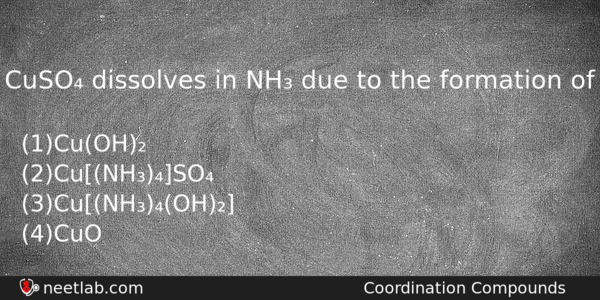| ⇦ | 
| ⇨ |
CuSO₄ dissolves in NH₃ due to the formation of
Options
(a) Cu(OH)₂
(b) Cu[(NH₃)₄]SO₄
(c) Cu[(NH₃)₄(OH)₂]
(d) CuO
Correct Answer:
Cu[(NH₃)₄(OH)₂]
Explanation:
NH₃+ H₂O→ NH₄OH
CuSO₄ + NH₄OH → Cu(OH)₂ + (NH₄)₂ SO₄ / Cu(OH)₂ + 2NH₄OH + (NH₄)₂ SO₄ → [Cu (NH₂)₄] SO₄ + 4 H₂O ( Tetrammine cupric sulphate
The complex is called as Schotzer’s reagent which is used for dissolving cellulose in the manufacture of artificial silk.
Related Questions: - In the chemical reaction
2SO₂ + O₂ ⇌ 2SO₃,
increasing the total pressure leads to
- Pyrolusite is an ore of
- If ionization potential for hydrogen atom is 13.6eV, then ionization potential
- Hydro-metallurgical process of extraction of metals is based on
- In the electrolytic refining of zinc
Topics: Coordination Compounds
(87)
Subject: Chemistry
(2512)
Important MCQs Based on Medical Entrance Examinations To Improve Your NEET Score
- In the chemical reaction 2SO₂ + O₂ ⇌ 2SO₃, increasing the total pressure leads to
- Pyrolusite is an ore of
- If ionization potential for hydrogen atom is 13.6eV, then ionization potential
- Hydro-metallurgical process of extraction of metals is based on
- In the electrolytic refining of zinc
Topics: Coordination Compounds (87)
Subject: Chemistry (2512)
Important MCQs Based on Medical Entrance Examinations To Improve Your NEET Score
18000+ students are using NEETLab to improve their score. What about you?
Solve Previous Year MCQs, Mock Tests, Topicwise Practice Tests, Identify Weak Topics, Formula Flash cards and much more is available in NEETLab Android App to improve your NEET score.
Share this page with your friends

Leave a Reply